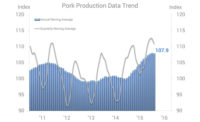Independent Thoughts
U.S. pork exports weathering a challenging market

Despite cost pressures and market instability around the world, U.S. pork exports are showing some bright spots.
According to the latest Rabobank Pork Report, these factors are influencing pork markets around the world:
- Producers are experiencing decreased pressure as feed and energy costs soften.
- Global pork trade flows declined in the first half of 2022, with a major impact being China’s pork imports tumbling 65% year over year, along with global political instability, disease and ongoing supply chain issues.
- African swine fever cases are spreading across Europe, Asia and North America, where the disease’s spread is being combatted through accelerated education and prevention efforts.
- Pork demand remains resilient due to its position as a mid-cost protein.
- U.S. pork industry exports were up 16% year over year to Mexico, offsetting declining exports to China.
The U.S.’s southern neighbor remains a strong market for pork, with the U.S. Meat Export Federation finding that exports to Mexico are holding on as the largest destination for U.S. pork, building off last year’s record shipments. USMEF said May exports totaled 79,849 metric tons, up 12% from year-ago numbers with a 13% increase in value as well at $171.2 million. Through May, exports to Mexico are up 22% to 396,934 metric tons valued at $715.1 million (up 12%), according to USMEF.
As U.S. pork shipments to Mexico are setting a record pace, demand is strong across most of the Western Hemisphere. In response to rising consumer prices and fears of food insecurity, Mexico recently suspended its import duties on pork muscle cuts for one year.
According to USMEF market research, China’s hog prices have risen about 40% since mid-June, and that trend should result in a rebound in China’s demand for imported pork toward the end of 2022.
According to the U.S. Department of Agriculture’s June Hogs and Pigs report, the U.S. sow herd was 0.8% below year-ago levels.
Looking for a reprint of this article?
From high-res PDFs to custom plaques, order your copy today!
.png?height=96&t=1647275041&width=96)






